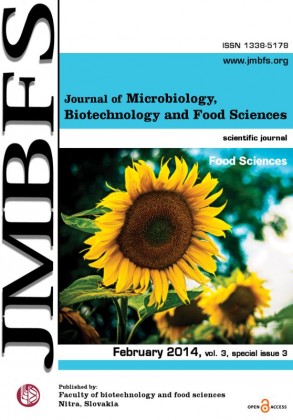OFFICIAL CONTROL OF WHEAT MYCOTOXINS CONTAMINATION IN THE SLOVAK REPUBLIC
Keywords:
mycotoxins, wheat, Slovak republicAbstract
It is important for the protection of public health that maximum levels are set on unprocessed cereals in order to avoid, that highly contaminated cereals can enter the food chain and to encourage and ensure that all measures are taken during the field, harvest and storage stage of the production chain. The contamination of winter wheat grain by toxins with focus on the genus Fusarium was monitored within the years 2009 – 2011 under the official control according to EC Regulation 401/2006 and 178/2010 on the territory of the Slovak Republic. The concentration of deoxynivalenol (DON) and nivalenol was determined by HPLC/DAD detector and concentration of zearalenone (ZEA) by HPLC/FLD detector. Deoxynivalenol was the most common (dominant) Fusarium toxins in 2009-2011 with a concentration ranging from 20 µg.kg-1 - 2 651.79 µg.kg-1. 4 samples contained the content of deoxynivalenol which was over the EC Regulation no. 1881/2006 about setting the maximum levels for certain contaminants in foodstuff. Trichothecenes nivalenol occurred regularly together with deoxynivalenol. 12 % of wheat samples were contaminated with two toxins deoxynivalenol and zearalenone, 7 % of samples were analyzed for concurrent occurrence of zearalenone + deoxynivalenol + nivalenol.Downloads
Download data is not yet available.
Downloads
Published
2014-02-01
How to Cite
Remža, J., Lacko-BartoÅ¡ová, M., & KosÃk, T. (2014). OFFICIAL CONTROL OF WHEAT MYCOTOXINS CONTAMINATION IN THE SLOVAK REPUBLIC. Journal of Microbiology, Biotechnology and Food Sciences, 3(special issue 3 (Food Sciences), 270–272. Retrieved from https://office2.jmbfs.org/index.php/JMBFS/article/view/7589
Issue
Section
Food Sciences
License
Copyright (c) 2014 Jaroslav Remža, Magdaléna Lacko-BartoÅ¡ová, Tomáš KosÃk

This work is licensed under a Creative Commons Attribution 4.0 International License.
All papers published in the Journal of Microbiology, Biotechnology and Food Sciences are published under a CC-BY licence (CC-BY 4.0). Published materials can be shared (copy and redistribute the material in any medium or format) and adapted (remix, transform, and build upon the material for any purpose, even commercially) with specifying the author(s).

